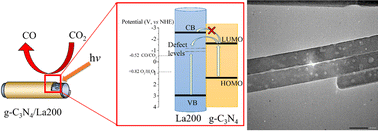Interface modification by defect engineering for g-C3N4/LaPO4−x nanorods towards efficient CO2 photoreduction†
Abstract
In this work, a series of specific surface defects are introduced at the interface of LaPO4/g-C3N4 composites. The photoreduction of CO2 into CO was performed to evaluate the catalytic performance. Among all photocatalysts, g-C3N4 composited with La200 (g-C3N4/La200) samples exhibits the best photocatalytic activity. The yield rate of CO for g-C3N4/La200 is almost 2 times, 2 times, 5 times and 18 times higher than that of La200, g-C3N4, pristine LaPO4 and g-C3N4/LaPO4 samples, respectively. It was revealed that these specific defects (oxygen vacancies) were successfully introduced onto LaPO4−x nanorods’ surface (La200 samples) and the g-C3N4 shell completely covered the LaPO4−x nanorods (La200). The introduced oxygen vacancies induced a new defect level below the CB (conduction band bottom) of LaPO4. The photoexcited electrons in the LUMO energy levels of g-C3N4 can easily transfer to the defect energy levels of LaPO4−x. Consequently, the response in the visible region is extended and the photoinduced holes and electrons are separated efficiently. As a result, the La200 samples represented enhanced activity towards CO2 reduction into carbon monoxide. This study may offer better guidance for designing and fabricating novel heterostructure photocatalysts by defect engineering with excellent photocatalytic activity and stability.



 Please wait while we load your content...
Please wait while we load your content...